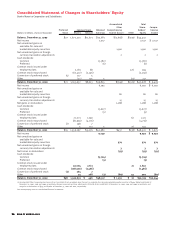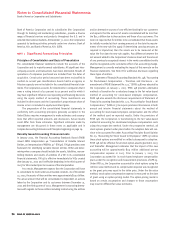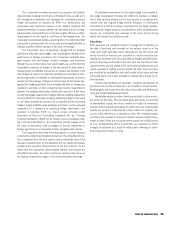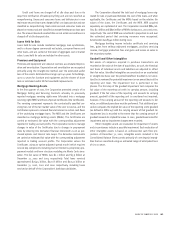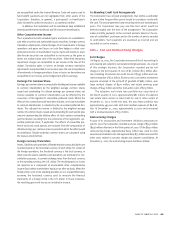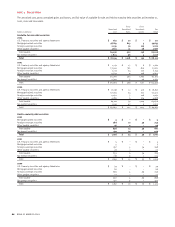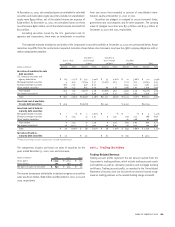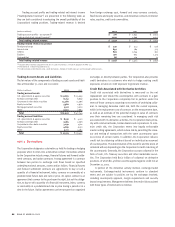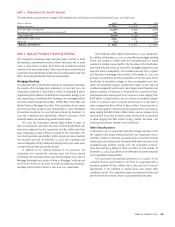Bank of America 2002 Annual Report Download - page 84
Download and view the complete annual report
Please find page 84 of the 2002 Bank of America annual report below. You can navigate through the pages in the report by either clicking on the pages listed below, or by using the keyword search tool below to find specific information within the annual report.
82 BANK OF AMERICA 2002
Special Purpose Financing Entities
In the ordinary course of business, the Corporation supports its
customers financing needs by facilitating these customers’ access to
different funding sources, assets and risks. In addition, the
Corporation utilizes certain financing arrangements to meet its bal-
ance sheet management, funding, liquidity, and market or credit risk
management needs. These financing entities may be in the form of cor-
porations, partnerships or limited liability companies, or trusts and
are not consolidated in the Corporation’s balance sheet. The majority
of these activities are basic term or revolving securitization vehicles
such as credit cards or mortgages. These vehicles are generally funded
through term-amortizing debt structures designed to be paid off based
on the underlying cash flows of the assets securitized.
Securitizations
The Corporation securitizes, sells and services interests in residential
mortgage, consumer finance, commercial and credit card loans.
When the Corporation securitizes assets, it may retain interest-only
strips, one or more subordinated tranches and, in some cases, a cash
reserve account, all of which are considered retained interests in the
securitized assets. Gains upon sale of the assets depend, in part, on
the Corporation’s allocation of the previous carrying amount of the
assets to the retained interests. Previous carrying amounts are allo-
cated in proportion to the relative fair values of the assets sold and
interests retained.
Quoted market prices, if available, are used to obtain fair values.
Generally, quoted market prices for retained interests are not avail-
able; therefore, the Corporation estimates fair values based upon the
present value of the associated expected future cash flows. This may
require management to estimate credit losses, prepayment speeds,
forward yield curves, discount rates and other factors that impact
the value of retained interests.
The excess cash flows expected to be received over the amor-
tized cost of the retained interest is recognized as interest income
using the effective yield method. If the fair value of the retained inter-
est has declined below its carrying amount and there has been an
adverse change in estimated contractual cash flows of the underlying
assets, then such decline is determined to be other-than-temporary
and the retained interest is written down to fair value with a corre-
sponding adjustment to earnings.
Other Special Purpose Financing Entities
Other Special Purpose Financing Entities are generally funded with
short-term commercial paper and are similarly paid down through the
cash flow or sale of the underlying assets. These financing entities
are usually contractually limited to a narrow range of activities that
facilitate the transfer of or access to various types of assets or finan-
cial instruments and provide the investors in the transaction protec-
tion from creditors of the Corporation in the event of bankruptcy or
receivership of the Corporation. In certain situations, the Corporation
provides liquidity commitments and/or loss protection agreements.
See Note 13 for further discussion.
The Corporation evaluates whether these entities should be
consolidated by applying generally accepted accounting principles
and interpretations that generally provide that a financing entity is not
consolidated if both the control and risks and rewards of the assets in
the financing entity are not retained by the Corporation. In determining
whether the financing entity should be consolidated, the Corporation
considers whether the entity is a qualifying special-purpose entity
(QSPE) as defined in Statement of Financial Accounting Standards
No. 140, “Accounting for Transfers and Servicing of Financial Assets
and Extinguishments of Liabilities – a replacement of FASB Statement
No. 125,” (SFAS 140). For non-consolidation, SFAS 140 requires that
the financing entity be legally isolated, bankruptcy remote and beyond
the control of the seller, which generally applies to securitizations. For
non-QSPE structures, the Securities and Exchange Commission and
the EITF also have issued guidance regarding consolidation of financ-
ing entities. Such guidance applies to certain transactions and
requires an assessment of whether sufficient risks and rewards of
ownership have passed based on assessing the voting rights, control
of the entity and the existence of substantive third party equity invest-
ment. For additional information on the consolidation of financing
entities, see Recently Issued Accounting Pronouncements in Note 1. As
part of its normal risk management activities, the Corporation enters
into certain transactions that are facilitated through a special purpose
entity (SPE). The Corporation consolidates certain of these SPEs when
it believes, under the current accounting guidance, that consolidation
is appropriate.
For further discussion on Special Purpose Financing Entities
see Note 8.
Income Taxes
There are two components of income tax expense: current and deferred.
Current income tax expense approximates cash to be paid or refunded for
taxes for the applicable period. Deferred tax assets and liabilities are
recognized due to differences in the basis of assets and liabilities as
measured by tax laws and their basis as reported in the financial
statements. Deferred tax expense or benefit is then recognized for the
change in deferred tax liabilities or assets between periods.
Recognition of deferred tax assets is based on management’s
belief that it is more likely than not that the tax benefit associated
with certain temporary differences, tax operating loss carryforwards
and tax credits will be realized. A valuation allowance is recorded for
the amount of the deferred tax items for which it is more likely than not
that realization will not occur.
Retirement Benefits
The Corporation has established qualified retirement plans covering
substantially all full-time and certain part-time employees. Pension
expense under these plans is charged to current operations and
consists of several components of net pension cost based on various
actuarial assumptions regarding future experience under the plans.
In addition, the Corporation and its subsidiaries have established
unfunded supplemental benefit plans and supplemental executive
retirement plans for selected officers of the Corporation and its sub-
sidiaries that provide benefits that cannot be paid from a qualified
retirement plan due to Internal Revenue Code restrictions. These plans




